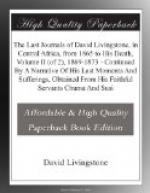One sees interminable grassy prairies with lines of trees, occupying quarters of miles in breadth, and these give way to bouga or prairie again. The bouga is flooded annually, but its vegetation consists of dry land grasses. Other bouga extend out from the Lake up to forty miles, and are known by aquatic vegetation, such as lotus, papyrus, arums, rushes of different species, and many kinds of purely aquatic subaqueous plants which send up their flowers only to fructify in the sun, and then sink to ripen one bunch after another. Others, with great cabbage-looking leaves, seem to remain always at the bottom. The young of fish swarm, and bob in and out from the leaves. A species of soft moss grows on most plants, and seems to be good fodder for fishes, fitted by hooked or turned-up noses to guide it into their maws.
One species of fish has the lower jaw turned down into a hook, which enables the animal to hold its mouth close to the plant, as it glides up or down, sucking in all the soft pulpy food. The superabundance of gelatinous nutriment makes these swarmers increase in bulk with extraordinary rapidity, and the food supply of the people is plenteous in consequence. The number of fish caught by weirs, baskets, and nets now, as the waters decline, is prodigious. The fish feel their element becoming insufficient for comfort, and retire from one bouga to another towards the Lake; the narrower parts are duly prepared by weirs to take advantage of their necessities; the sun heat seems to oppress them and force them to flee. With the south-east aerial current comes heat and sultriness. A blanket is scarcely needed till the early hours of the morning, and here, after the turtle doves and cocks give out their warning calls to the watchful, the fish-eagle lifts up his remarkable voice. It is pitched in a high falsetto key, very loud, and seems as if he were calling to some one in the other world. Once heard, his weird unearthly voice can never be forgotten—it sticks to one through life.
We were four hours in being ferried over the Loitikila, or Lolotikila, in four small canoes, and then two hours south-west down its left bank to another river, where our camp has been formed. I sent over a present to the headman, and a man returned with the information that he was ill at another village, but his wife would send canoes to-morrow to transport us over and set us on our way to Muanazambamba, south-west, and over Lolotikila again.
14th April, 1873.—At a branch of the Lolotikila.
15th April, 1873.—Cross Lolotikila again (where it is only fifty yards) by canoes, and went south-west an hour. I, being very weak, had to be carried part of the way. Am glad of resting; ai mua flow copiously last night. A woman, the wife of the chief, gave a present of a goat and maize.
16th April, 1873.—Went south-west two and a half hours, and crossed the Lombatwa River of 100 yards in width, rush deep, and flowing fast in aquatic vegetation, papyrus, &c., into the Loitikila. In all about three hours south-west.




